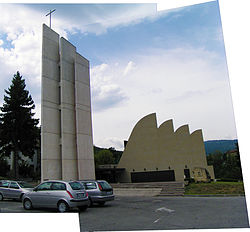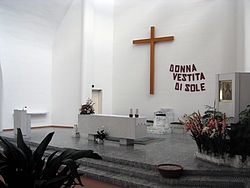- Church of the Assumption of Mary, Riola di Vergato
-
The Church of the Assumption of Mary, Riola di Vergato, Italy was designed by Finnish architect Alvar Aalto, is located in Riola, a village in the commune of Vergato, in the province of Bologna, Italy. It was built starting in 1975 and was consecrated in 1978, with the Campanile completed as late as 1993[1]. Design on the project began in 1965-66 after the Archbishop of Bologna, Cardinal Giacomo Lercaro, secured Aalto's paticipation upon seeing his work in an exhibition in Florence at the Palazzo Strozzi[2]. Lercaro was a participant in the reforms of Vatican II which had occurred in the previous four years, and had also commissioned architects Kenzo Tange and Le Corbusier to design churches in his domain[2]. Because both Aalto and Lercaro died in 1976, and only some portions of the project masterplan were completed, this work could be considered posthumous, and some have argued, fragmentary[3].
The church is structured by six asymmetric prefabricated concrete frames, or arches in descending size towards the chancel, that support a series of prefabricated light scoops, which are conic sections, giving the church its distinctive exterior profile, which some liken to an abstraction of the local Apennine mountains[1]. The facades are faced with mortared stone, and the roof is copper sheeting. The interior is mostly whitewashed plaster, which advantageously reflects the northern light brought in from the scoops above. Wooden pews, each slightly shorter in length than the preceding one as they approach the chancel are placed on the terra cotta tile floors. The altar is unadorned and hewn from a single block of marble. The tabernacle is also designed by Aalto, although it is not in its original location[1] . A slightly sunken hexagonal baptistery is appended to the northwest corner of the church, that has a large pyramidal skylight placed over the baptismal font as well as a vertical slit window viewing the Limentra torrent, which flows by the church to the north.
More than other projects of Aalto, the architecture of the church references both the distinctive light fixtures Aalto designed as well as his bent plywood furniture produced by his company Artek.
References
- ^ a b c Trebbi, Giorgio (1999). Chiesa di Riola. Bologna, Italy: Grafiche Ruggero.
- ^ a b Schildt, Goran (1991). Alvar Aalto The Mature Years. New York: Rizzoli. pp. 223–224. ISBN 0-8478-1329-0.
- ^ Schildt, Goran (1994). Alvar Aalto The Complete Catalog of Architecture, Design and Art. New York: Rizzoli. pp. 55–56. ISBN 0-8478-1818-7.
External links
Categories:- Churches in Emilia-Romagna
- Alvar Aalto buildings
- Religious buildings completed in 1978
- 20th-century church buildings
- Religious organizations established in 1978
Wikimedia Foundation. 2010.



